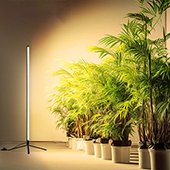I don’t like being asked the question: do plants grow better in sunlight or in LED grow lights?
If you’re after the most natural, eco-friendly option and have access to abundant sunlight, then natural light is better. However, if you need better control over growth conditions or face geographical or seasonal limitations, LED plant lights can provide benefits that sunlight can’t match.
Ideally, a combination of both light sources would be the best choice to maximize plant health and yield. Some commercial operations use natural light supplemented with artificial plant growth lights to achieve the best results.
Modern greenhouses incorporate the best practices of both indoor and outdoor cultivation. In terms of lighting, this means carefully balancing natural sunlight with supplemental light. It’s revolutionizing how people grow crops outdoors.
Here, we’ll share some professional insights on greenhouse supplemental lighting applications from Brendan Strath, the Advanced Solutions Director, and Plant Ninja:
How important is supplemental lighting in greenhouse cultivation and what are its main benefits?
Stability in Crop Production: Greenhouse supplemental lighting has become a vital component of outdoor agriculture. By providing a consistent light source in the greenhouse, growers can maintain crop production during short winter days and adverse weather conditions.
Cost Reduction: Combining natural sunlight with supplemental lighting significantly lowers production costs. Unlike indoor cultivation where each light may need to run at full capacity all day (especially during peak sunlight hours), greenhouse lighting is often more dispersed.
As a result, the lights operate for shorter durations, cover larger areas, and greatly reduce the cost per square foot of canopy compared to indoor setups.
What do you believe is the most significant benefit of supplemental lighting in greenhouse cultivation?
For me, the primary impact of using supplemental lighting in greenhouse cultivation lies in its effect on the carbon footprint.
Utilizing the world’s most potent light source—the sun—to carry out the heavy lifting and supplementing with just a few hours of light each day when sunlight intensity is low is a more environmentally friendly method of crop production compared to cultivating directly indoors.
Additionally, employing this approach allows for year-round production of high-quality crops, leading to cost savings in the production process.
Is the use of supplemental lighting more prominent among growers in some parts of the U.S. than others? If so, why?
That’s a great question and often overlooked. Yes, at first glance, some regions are more conducive to greenhouse cultivation than others.
Any area with extreme weather conditions (such as cold temperatures, strong winds, snow, etc.) is highly suitable for greenhouses; they provide environmental protection for crops while harnessing sunlight.
In regions with limited sunlight, supplemental lighting also proves beneficial for crops. However, with careful planning and ingenuity, greenhouse cultivation can be effectively employed in almost any location on Earth.
Source: Maximum Yield 01/18/19. “Combining Sunlight and Grow Lights: Supplemental Greenhouse Lighting” https://www.maximumyield.com/combining-sunlight-and-grow-lights-supplemental-greenhouse-lighting/2/17467




